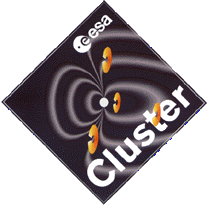

Cluster is a European Space Agency (ESA) project comprising four satellites to fly in formation with separation distances ranging from 200 to 10000 km. The Cluster spacecraft were first launched from Kourou on 4 June 1996 on the first flight of the new Ariane 5 launch vehicle. The launch was not successful and the four spacecraft were lost. In April 1997 ESA decided to build four identical replacements, which were launched in pairs on Soyuz launchers from Baikonur on 16 July and 9 August 2000.
The orbit is 4 by 20 Earth radii with an inclination of 90 degrees. The scientific objective is to study the fine-structure of and small-scale phenomena in magnetospheric boundary layers, in particular the polar cusp and the magnetopause. The Alfvén Laboratory is responsible for part of the analogue electronics for the electric fields and waves instrument (EFW), and for setting up the Scandinavian Data Centre which is part of the Cluster Science Data System.
The four spacecraft, Rumba, Salsa, Samba, and Tango, are since early January 2001 in the operational phase, following extended commissioning during the second half of 2000. With a few exceptions all instruments are performing as expected.
Access to data and planning information:
Other links:
This page is maintained by Per-Arne
Lindqvist.
Latest update: 18 January 2001.